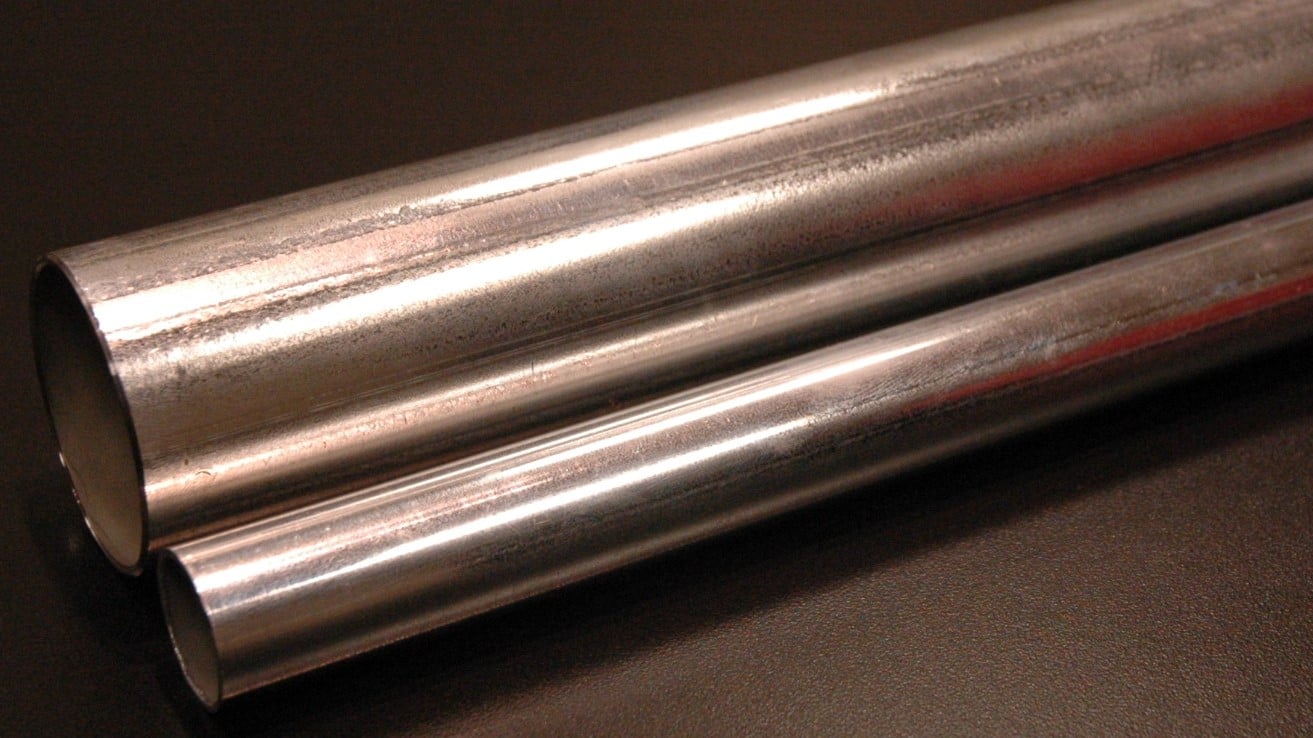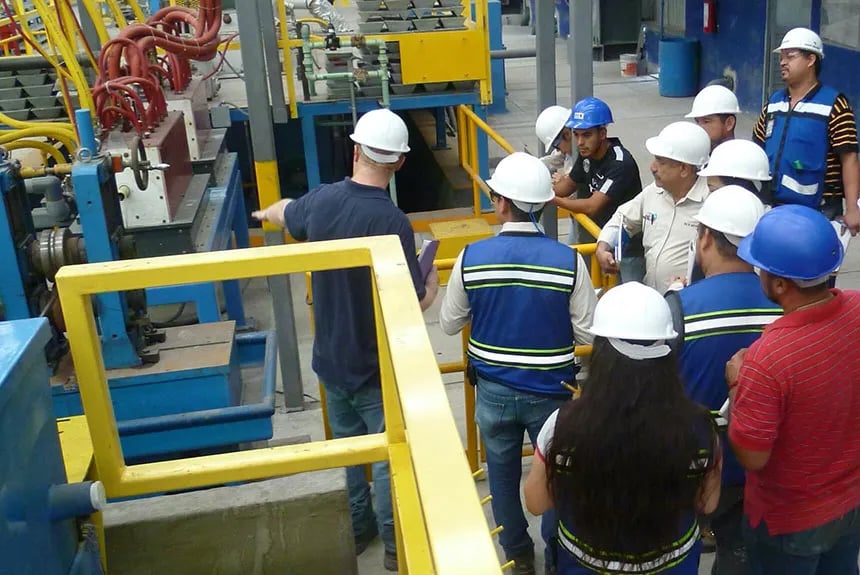Authored by Peter Chifo, Jr.
(A segment of this blog was originally published in The Fabricator)

Exterior Secondary Coating Operations
While galvanized tubulars and shapes provide considerable protection against corrosion, their performance and aesthetics may be further enhanced through application of a secondary coating or hybrid coating process. In addition to galvanized substrates, un-coated black mechanical tubes may utilize these secondary in-line processes to add utility, performance and value presenting many opportunities to non-galvanized tube and pipe producers. These secondary coating operations primarily act to shield the underlying substrates by forming a distinct protective barrier which insulates the surface from potentially harmful elements. In general to be effective coatings should possess the following properties. The coating should be continuous and substantially impervious to its subject environment while remaining resistant to damage such as abrasion or scratching. It should not electrolytically accelerate the attack on its substrate. Finally, the coating should exhibit good adhesion and ductility if the end use of the base product is intended for fabrication. It should be noted that coatings for application over tubular products are considered to be specific use formulations. They are meant to perform specific tasks with regard to corrosion protection, product aesthetics or in some cases to provide a materials advantage to allow the use of a more economical component. It is not uncommon for these coatings to require some degree of on-line tuning to optimize their performance and compensate for process or other production variables. Once these final modifications are completed the coatings will rarely require anything other than proper agitation to achieve their intended performance.
There are a number of coating technologies available for the many products which can be produced with the continuous galvanizing process. In general, each coating will also have process application technologies which is unique to each coating type. This section will present the four most prevalent coatings currently utilized over the outside diameter of galvanized tubulars and shapes. It is assumed that with any of the coating technologies discussed proper cleaning and pretreatment should be undertaken prior to the coating application.
Air-Dry Coatings
As the name suggests, air dry coatings are formulations which require either little or no auxiliary heat source to cure the coating. Traditionally these are solvent rich lacquers which have relatively low solids contents and high solvent concentrations. These air-dry formulations may be clear or contain pigments to add colour to the surface of the product. This form of coating is considered to provide the least amount of corrosion protection and is generally utilized for short term storage protection. Electrical conduit is a suitable use for air dry coatings provided that inventories are only subjected to a moderately corrosive environment. Typically, air-dry coatings are applied by utilizing a flood and wiping apparatus. Dry film thickness is controlled by coating viscosity and wiping pressure with average films measuring approximately .0003". After application and wiping of the coating the solvents will evaporate or flash off and leave behind the thin film of solids as protection to the underlying zinc. Of all coating technologies the air-dry system requires the least amount of capital equipment, requires the least amount of line length but in return provides the least amount of corrosion protection.
Heat Cured Coatings
Heat cured coatings require a heat input generally provided by an induction or infrared heating unit to raise the tubing surface to a temperature where the coating becomes set or cures. These coatings are normally moderate in solids volumes and utilize a polyester resin or a water base, acrylic latex resin base. These coatings are most often clear but may in some cases utilize a pigment to both add colour as well as enhance corrosion performance. Heat cured coatings are considered to provide moderate to good corrosion protection for most tubular products and shapes (pipe, tube, square). Corrosion protection can be directly related and effected by the products pretreatment method, coating dry film thickness and continuity. Most heat dry coatings are applied with good results utilizing a flood and wiping system similar to that utilized in application of air-dry formulations. Dry film thickness is again controlled by coating viscosity with average depositions ranging from .0003" to as high as .0008" as dictated by the desired level of performance. Due to the flexibility and moderate cost of heat cured formulations, they are popular for use on electrical conduit, residential fence tubing and some galvanized mechanical tube applications. Cost of the equipment related to the use of heat cured coatings would be considered moderate when compared to the three other coating technologies.
Ultraviolet (UV) Cured Coatings
UV cured coatings are formulated with a photo reactive component which allows the coating to cure when an ultraviolet light source is introduced. UV cured coatings are virtually 100% solids by volume which means that no solvent component is present. This full solids content coupled with the high transfer efficiencies associated with current application equipment makes UV curables the only liquid coating technology which is essentially 100% efficient. An attribute only presently matched by powder systems. UV cured coatings can be applied by any of three means, flood and wiping, spray enclosure or vacuum applicator. Coatings again may be clear or pigment. Once applied to a wet film thickness of between .0005" and .001" dependent on desired protection, the product is passed through a series of lights which excite the photo reactive nature of the coating and an almost instantaneous cure is achieved UV cured coatings are primarily used when enhanced corrosion performance will substantially improve a products useful life and value. While higher than average in applied costs, UV coatings costs are often offset by the products corrosion resistance. Products which are typically produced utilizing UV cured coatings are both residential and commercial fence tubing, some galvanized mechanical tubing applications as well as galvanized structural tubing. Capital cost of the equipment required to apply and cure UV cure coatings is higher compared to the other three coatings. However, when high performance, line space and quality is an issue, UV will most often be the process of choice.
Heat Cured Powders
Heat cured powder coatings differ from the preceding technologies in that the product applied is actually a powder and not a liquid. The use of powder over tubular products is not new, for many powders have been applied offline on conveyor type process lines. Today the technology exists to apply powder coatings in-line to produce the ultimate in corrosion performance. Powder coatings developed and grew throughout the 1970's and 1980's due their environmental desirability. Application cost and the inability to efficiently control coating weight made powder economically unfeasible for all but a limited volume market. Today powder refinement and application equipment has evolved to a point where powder is more attractive where there is an economic justification for a superior product.
Powder can be applied utilizing a fluidized bed, electrostatic fluidized bed, flocking or by electrostatic gun. Thermosetting powders when heated to a predetermined temperature undergo a chemical reaction and fuse creating an excellent adhering, highly corrosion resistant surface. As with the heat cured coating described above, powders are cured after application by means of an induction heating unit. Once the predetermined temperature is reached the product may be cooled immediately and no further processing or treatment is required. Due to the economic considerations of powder the application is at present limited to some residential and commercial grade fence tubing as well as mechanical and structural applications. Capital cost of the process associated with the application of powder is high compared to the other coating methods previously discussed, however in-line applications will prove to be far more efficient and cost effective than their offline counterparts.
Interior Primary Coatings
As the continuous galvanizing process coats the exterior surface of welded tubular products, some form of corrosion resistance is required for internal surfaces of the product. Typically, this is accomplished by spraying a specially formulated coating through a lance apparatus placed into the tube at the forming section of the tube or pipe mill. Once again, the coating formulation is dependent upon the finished product's end use and its associated performance requirements. Of the four product categories produced by the continuous galvanizing process, three basic coating types are used for interior finishing.
Interior Primers
These coatings are designed primarily for general corrosion resistance for use with residential or non-spec fence tubing, mechanical tube applications such as scaffolding as well as some galvanized structural products. Basically, these formulations are low to mid solids by volume with either solvent or water carrier fluids. Pigments are generally used to enhance product performance and to act as an indicator for product coverage. This coating type will provide excellent corrosion resistance for most uses, with the degree of protection directly related to dry film thickness. No special considerations for application other than proper agitation and application viscosity need be given for optimal product performance.
Zinc Rich Coatings
Zinc rich coatings are intended for use when maximum corrosion resistance is desired. Zinc rich formulations represent an attempt to combine the sacrificial corrosion protection of zinc with the barrier film protection of interior primers. Finely milled metallic zinc particles are mixed and imbedded into a resin matrix. Even though the zinc particles are covered by a thin film of resin they still possess a relatively good path of conductivity to allow the zinc to retain its strong electropositive characteristics. Due to the high molecular weight of the additional zinc powder, special consideration must be given to ensure that the zinc powder which settles during shipment and while in inventory is re-dispersed prior to coating application. This is accomplished by utilizing special mixing and dispersing equipment which is designed to properly agitate the coating thereby keeping the zinc element in solution and homogeneous throughout the container. These zinc rich coatings are designated for use with commercial or spec grade fence tubing, in some severe duty mechanical applications as well as galvanized structural products where the product will have to endure severe environmental conditions.
Conduit Coatings
Coatings formulated for use on conduit products must be designed to meet additional performance criteria from those intended strictly for corrosion resistance. Due to conduits use as an electrical wire way or enclosure one especially important factor is its ability to allow the insertion and pulling of electrical wiring. This requirement makes the internal surface finish and a low coefficient of friction characteristics of the coating extremely critical for proper performance. In addition to the low friction characteristics, conduit coatings must also meet certain requirements set forth by various underwriting agencies such as Underwriters Laboratories. These requirements are set as standards to ensure coating adhesion and flexibility as the finished product will most likely undergo bending during installation. Generally, coatings for conduit use are low to mid volume solids and may utilize either a solvent or water carrier fluid. As corrosion resistance characteristics are not as demanding as severe duty applications these conduit coatings provide acceptable results at dry film thickness of as little as .0003" to .0004".
Conclusion
Hot dip & In-line Galvanizing and coating of tubular products and shapes has been utilized for many years as a means of corrosion resistance by significantly extending the useful life of carbon steel-based products. However, the processes which have been traditionally employed are rapidly becoming dated when compared to the efficient, cost effective and versatile process technologies now available. Today’s manufacturing environment dictates that producers must establish a position of strength through efficiency and develop a competitive edge through versatility and innovation. It will be through the use of these continuous coating processes that carbon steel will continue to be the material of choice for a multitude of traditional as well as innovative new tubular products and shapes for many years to come.
If you wish to request us with some questions or doubts, please feel free to leave a request with the below link, our team of experts are always keen to support and help innovations for galvanized metal productions...



